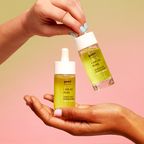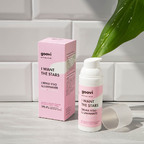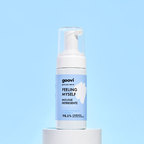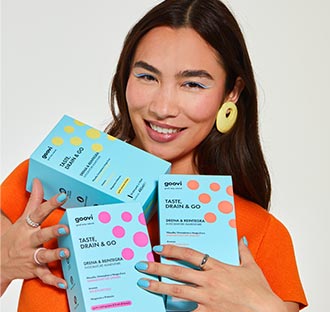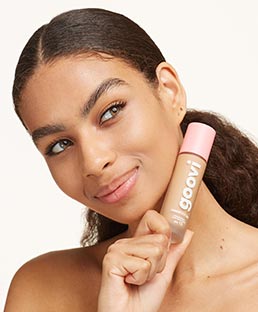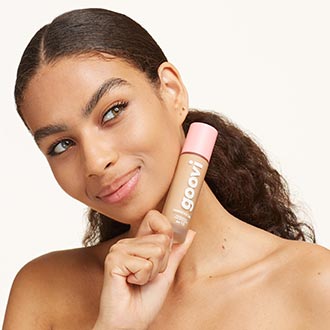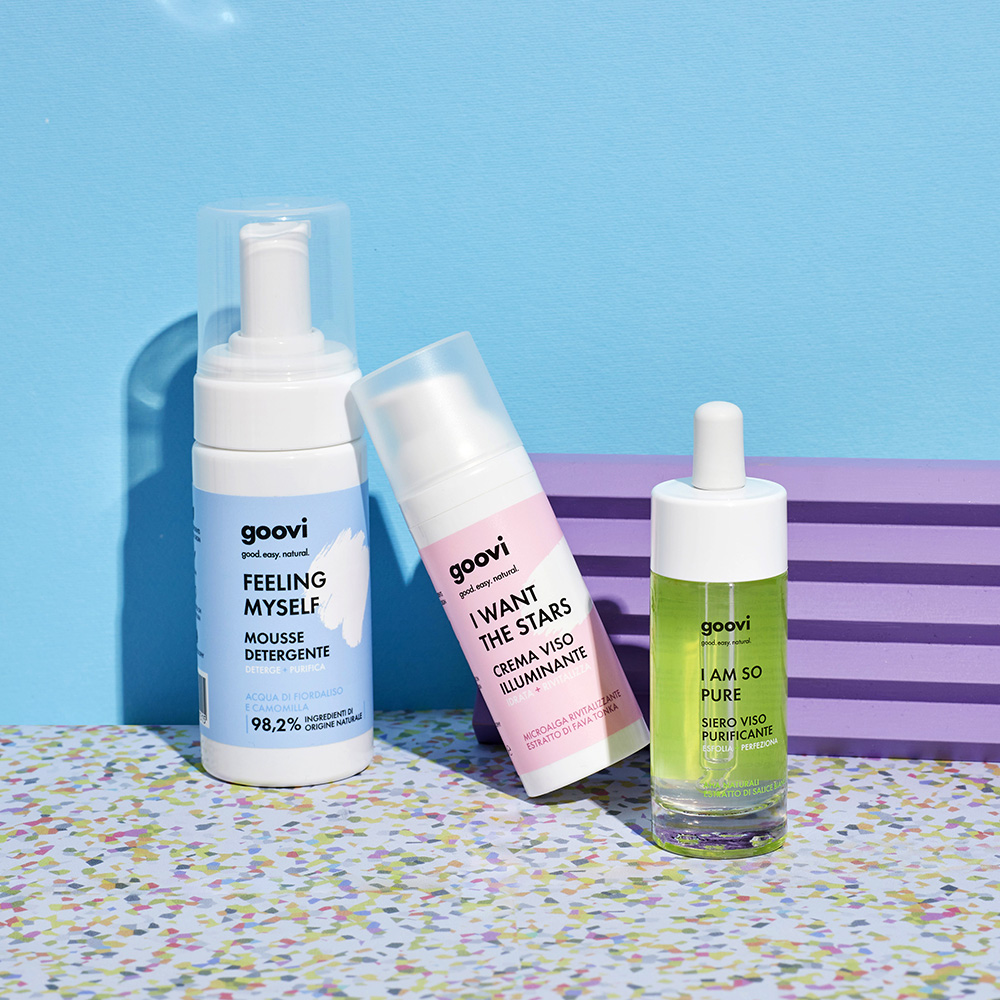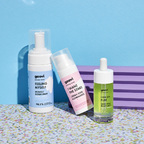set beauty routine skin with no blemishes
set beauty routine skin with no blemishes
€64.70
-18%
€53.17
cleanses + moisturises + exfoliates + brightens: remove impurities with a soft cleansing mousse and exfoliate with purifying face serum. For smooth, even skin with no impurities. Complete your routine, with our brightening face cream!
The set contains:
1. I am so pure: purifying face serum with 98.2% ingredients of natural origin. Thanks to the presence of 5 natural AHAs (extracted from sugar cane, blueberry, orange, lemon, and maple) with an exfoliating action, including Glycolic Acid (extracted from Sugar Cane), the skin becomes smooth, even and more radiant. Purifying fermented White Willow extract acts on impurities and blemishes, helping reduce pore visibility and purify very oily skins. It also contains a blend of amino acids, sugars, and vitamins, such as niacinamide, which leave the skin soft and smooth, and Tonka Bean Extract, which makes it brighter and more even. Ideal for all skin types, especially oily, blemished skin.
2. Feeling Myself: light and delicate, it removes impurities with respect for the skin's natural balance. Used every day, morning and evening, this mousse delicately caresses and cleanses even the most sensitive skin, leaving it soft and fresh with a pleasant scent.
3. I want the stars: brightening face cream, with ingredients that are 99.4% of natural origin, ensures lengthy moisturisation (24 hours) and revitalises the skin on your face, making it bright and elastic.
1. I am so pure: purifying face serum with 98.2% ingredients of natural origin. Thanks to the presence of 5 natural AHAs (extracted from sugar cane, blueberry, orange, lemon, and maple) with an exfoliating action, including Glycolic Acid (extracted from Sugar Cane), the skin becomes smooth, even and more radiant. Purifying fermented White Willow extract acts on impurities and blemishes, helping reduce pore visibility and purify very oily skins. It also contains a blend of amino acids, sugars, and vitamins, such as niacinamide, which leave the skin soft and smooth, and Tonka Bean Extract, which makes it brighter and more even. Ideal for all skin types, especially oily, blemished skin.
2. Feeling Myself: light and delicate, it removes impurities with respect for the skin's natural balance. Used every day, morning and evening, this mousse delicately caresses and cleanses even the most sensitive skin, leaving it soft and fresh with a pleasant scent.
3. I want the stars: brightening face cream, with ingredients that are 99.4% of natural origin, ensures lengthy moisturisation (24 hours) and revitalises the skin on your face, making it bright and elastic.
item code:
00086198000000
fermented tonka bean extract
Considered a good-luck charm in South America, it is the fruit of a tree in the Fabaceae family, which grows in Central America, between Mexico and Venezuela. The polyphenols in the fermented extract absorb UV radiation and emit it back out from your face. The result is brighter, revitalised skin.
camomile water
Camomile symbolises strength and resistance because its relaxing properties let you fight the strains of everyday life. The hydrolate in camomile is an excellent soother, especially good for people with very sensitive skin.
niacinamide
Niacinamide, or vitamin B3, is a multifunctional cosmetic active ingredient with excellent anti-ageing and rebalancing properties. Its antioxidant properties and the protection it offers from free radicals make it the ultimate anti-ageing agent, but it also has a moisturising effect on the skin barrier. Vitamin B3 supports the organism in forming the lipids and ceramides essential for ensuring the skin stays protected. An integral protective barrier ensures that the skin loses less liquids and can better withstand the effects caused by damaging external influences.
haematococcus pluvialis microalga
Haematococcus pluvialis, a green, single-cell microalga belonging to the Haematococcaceae family. It is a particularly concentrated natural source of astaxanthin, with antioxidant and photoprotective properties. This microalga is recommended for antioxidant support and has revitalising and restructuring properties.
betaine
Natural substance extracted from sugar beet (Beta vulgaris), from which it takes its name. Thanks to its outstanding humectant and moisturising properties, it is used in a wide range of cosmetic products. It is recommended for reducing irritation and protecting the skin from dryness.
natural AHAs
The acronym AHA stands for Alpha Hydroxy Acids, also known as Fruit Acids. The AHAs are organic acids sourced from fruit, plants or even milk, which have both moisturising and exfoliating effects on our skin. The most well-known AHAs are certainly Glycolic Acid (from sugar cane), lactic acid, citric acid (found in citrus fruits), malic acid (from apples) and tartaric acid (from grapes) but there are many more. They can be used on their own or combined with others, based on the treatment. AHA-based exfoliants have a gentle, yet effective action, removing impurities and promoting skin cell turnover.
fermented White Willow extract
The botanical name of White Willow is Salix Alba, and it belongs to the Salicaceae family. Originally from mild climates, it is now commonly found throughout Europe and West and North Africa. This plant has been used therapeutically since ancient times for the properties of its bark, rich in flavonoids, tannins, and salicin. Salicin, more commonly known as salicylic acid, is generally used on the skin for its astringent, toning and sebum-normalising properties.
purifying face serum
Apply on rinsed face with a light massage. Given the nature of the active ingredients, mild transient redness is possible upon application of the product. Avoid contact with the eyes.
cleansing mousse
Apply the product on your face and neck, massage it delicately with the ends of your fingers and rinse carefully.
illuminating face cream
apply to face, neck and upper chest with circular movements until fully absorbed, avoiding going near the eyes. Ideal for all skin types and as a foundation for make-up.
Apply on rinsed face with a light massage. Given the nature of the active ingredients, mild transient redness is possible upon application of the product. Avoid contact with the eyes.
cleansing mousse
Apply the product on your face and neck, massage it delicately with the ends of your fingers and rinse carefully.
illuminating face cream
apply to face, neck and upper chest with circular movements until fully absorbed, avoiding going near the eyes. Ideal for all skin types and as a foundation for make-up.
purifying face serum
aqua, lactobacillus/salix alba bark ferment filtrate, vaccinium myrtillus fruit extract, 1,2-hexanediol, propanediol, lactobacillus/dipteryx odorata seed ferment filtrate, hydroxypropyl guar, sodium pca, sodium lactate, saccharum officinarum extract, parfum, benzyl alcohol, sodium benzoate, citrus limon fruit extract, citrus aurantium dulcis fruit extract, acer saccharum extract, leuconostoc/radish root ferment filtrate, urea, glycine, niacinamide, fructose, inositol.
cleansing mousse
aqua, decyl glucoside, coco-glucoside, glycerin, betaine, centaurea cyanus flower water, chamomilla recutita flower water, propanediol, lauryl glucoside, sodium lauryl glucose carboxylate, cetearyl isononanoate, 1,2-hexanediol, benzyl alcohol, glyceryl oleate, xanthan gum, lactic acid, parfum*, sodium cocoamphoacetate, polyglyceryl-6 caprylate, polyglyceryl-4 caprate, sodium gluconate, almond/borage/linseed/olive acids/glycerides, sodium dehydroacetate, citric acid, benzoic acid, tocopherol, sodium benzoate, potassium sorbate. *con oli essenziali naturali
illuminating face cream
aqua, glyceryl stearate, dicaprylyl carbonate, myristyl lactate, dicaprylyl ether, glycerin, cetearyl alcohol, hydrogenated olive oil decyl esters, propanediol dicaprylate, almond/borage/linseed/olive acids/glycerides, lactobacillus/dipteryx odorata seed ferment filtrate, betaine, parfum*, triethyl citrate, xanthan gum, potassium cetyl phosphate, oryza sativa starch, glyceryl caprylate, haematococcus pluvialis extract, sodium lauroyl glutamate, sodium stearoyl lactylate, benzoic acid, sodium gluconate, leuconostoc/radish root ferment filtrate, tocopherol, arginine, citral. * con oli essenziali naturali
aqua, lactobacillus/salix alba bark ferment filtrate, vaccinium myrtillus fruit extract, 1,2-hexanediol, propanediol, lactobacillus/dipteryx odorata seed ferment filtrate, hydroxypropyl guar, sodium pca, sodium lactate, saccharum officinarum extract, parfum, benzyl alcohol, sodium benzoate, citrus limon fruit extract, citrus aurantium dulcis fruit extract, acer saccharum extract, leuconostoc/radish root ferment filtrate, urea, glycine, niacinamide, fructose, inositol.
cleansing mousse
aqua, decyl glucoside, coco-glucoside, glycerin, betaine, centaurea cyanus flower water, chamomilla recutita flower water, propanediol, lauryl glucoside, sodium lauryl glucose carboxylate, cetearyl isononanoate, 1,2-hexanediol, benzyl alcohol, glyceryl oleate, xanthan gum, lactic acid, parfum*, sodium cocoamphoacetate, polyglyceryl-6 caprylate, polyglyceryl-4 caprate, sodium gluconate, almond/borage/linseed/olive acids/glycerides, sodium dehydroacetate, citric acid, benzoic acid, tocopherol, sodium benzoate, potassium sorbate. *con oli essenziali naturali
illuminating face cream
aqua, glyceryl stearate, dicaprylyl carbonate, myristyl lactate, dicaprylyl ether, glycerin, cetearyl alcohol, hydrogenated olive oil decyl esters, propanediol dicaprylate, almond/borage/linseed/olive acids/glycerides, lactobacillus/dipteryx odorata seed ferment filtrate, betaine, parfum*, triethyl citrate, xanthan gum, potassium cetyl phosphate, oryza sativa starch, glyceryl caprylate, haematococcus pluvialis extract, sodium lauroyl glutamate, sodium stearoyl lactylate, benzoic acid, sodium gluconate, leuconostoc/radish root ferment filtrate, tocopherol, arginine, citral. * con oli essenziali naturali
Simona
Leonarda
